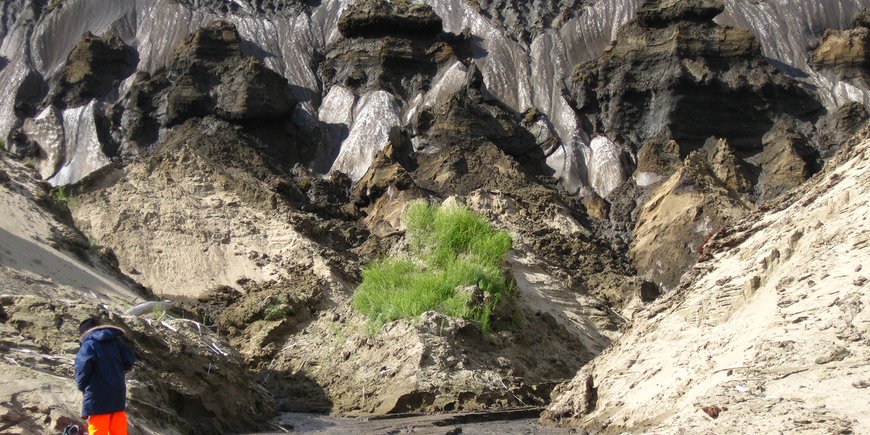In a seven-year laboratory study, Dr. Christian Knoblauch from Universität Hamburg’s Center for Earth System Research and Sustainability (CEN) and an international team have shown, for the first time, that significantly more methane is produced by thawing permafrost than previously thought. The findings, published in Nature Climate Change, make it possible to better predict how much greenhouse gas could be released by the thawing of the Arctic permafrost.
Methane (CH4) is a potent greenhouse gas, which is roughly 30 times more harmful to the climate than carbon dioxide (CO2). Both gases are produced in thawing permafrost as dead animal and plant remains are decomposed. However, methane is only formed if no oxygen is available. Until now, it was assumed that larger amounts of greenhouse gases are formed when the ground was dry and well aerated – when oxygen was available. Christian Knoblauch and his colleagues have now demonstrated that water-saturated permafrost soils without oxygen can be twice as harmful to the climate as dry soils – which means the role of methane has been greatly underestimated.
Knoblauch has, for the first time, measured and quantified in the laboratory the long-term production of methane in thawing permafrost. The team had to wait for three years before the approximately forty-thousand-year-old samples from the Siberian Arctic finally produced methane. The team observed the permafrost for a total of seven years: an unprecedented long-term study.
What they found: without oxygen, equal amounts of methane and CO2 are produced. But since methane is a far more potent greenhouse gas, it is more significant. Because methane production couldn’t be measured, it was assumed that in the absence of oxygen only very small amounts of it can be formed. “It takes an extremely long time until stable methane-producing microorganisms develop in thawing permafrost,” explains Knoblauch. “That’s why it was so difficult to demonstrate methane production until now.”
"By combining process-based and molecular-microbiological methods, our study shows for the first time that the methane-forming microorganisms in the thawing permafrost have significant influence on the greenhouse gas budget," adds co-author Susanne Liebner from the Helmholtz Center Potsdam - GFZ German Research Center for Geosciences.
The team has used the new data to improve a computer model that estimates how much greenhouse gas is produced in permafrost in the long term – and they’ve compiled a first forecasts. According to the soil scientist: The permafrost soils of Northern Europe, Northern Asia and North America could produce up to one gigaton of methane and 37 gigatons of carbon dioxide by 2100. But there are uncertainties. To what depth will the soil actually thaw by then? Will it be wet or dry? One thing, however, is certain: the new data will enable more accurate predictions about the impacts of thawing permafrost on our climate.
This is a release of Center for Earth System Research and Sustainability (CEN) at Universität Hamburg in cooperation with Helmholtz Center Potsdam – GFZ German Research Center for Geosciences.
Original study: Knoblauch, C., Beer, C., Liebner, S., Grigoriev, M.N., Pfeiffer, E.-M., 2018. Methane production as key to the greenhouse gas budget of thawing permafrost. Nature Climate Change, DOI: https://doi.org/10.1038/s41558-018-0095-z
Contact:
Dr. Christian Knoblauch
Center for Earth System Research and Sustainability (CEN)
Universität Hamburg
christian.knoblauch@uni-hamburg.de
Phone: +49 40 42838 2277
Stephanie Janssen
Center for Earth System Research and Sustainability (CEN)
Outreach
Universität Hamburg
stephanie.janssen@uni-hamburg.de
Phone: +49 40 42838 7596
Jun-Prof. Dr. Susanne Liebner
GFZ German Research Center for Geosciences Potsdam
GFZ section Geomikrobiology
Susanne.liebner@gfz-potsdam.de
Phone: +49 331 288 28817









![[Translate to English:] Torsten Sachs in front of a climate station on a field](/fileadmin/_processed_/3/9/csm__TorstenSachs_bearbeitet_GS_4a1365ef84.jpeg)

![[Translate to English:] left image flood at the Ahrtal: image from above, several houses are flooded; left image:: Heidi Kreibich;](/fileadmin/_processed_/4/4/csm_Bild2_9af0130e9f.png)



![[Translate to English:] Start der Vega Rakete](/fileadmin/_processed_/6/4/csm_20231201-kachel_Vega-VV23-launch_ESA-CNES-Arianespace_706716b68c.jpeg)









![[Translate to English:] Poster exhibition at the Brandenburg Hydrogen Day at the GFZ, some participants in the foreground](/fileadmin/_processed_/6/5/csm_Erster_Brandenburgischer_Wasserstofftag_GFZ_402fcec95e.jpeg)
![[Translate to English:] Group picture of the participants](/fileadmin/_processed_/9/4/csm_20231108_CAWa-Workshop-Tashkent_Gruppenbild_99ea779d8a.jpeg)

![[Translate to English:] [Translate to English:] Hörsaal](/fileadmin/_processed_/e/6/csm_H%C3%B6rsal_e21ac645fb.jpeg)


![[Translate to English:] The Delegations in the Historic Library on the Telegrafenberg. In the back there are from left to right, the Dutch Ambassador for Germany, Ronald van Roeden, the Dutch Minister for Education, Culture and Science, Robbert Dijkgraaf and the scientific director of the GFZ, Susanne Buiter.](/fileadmin/_processed_/d/b/csm_Kachel-2_9eba4b4212.jpeg)

